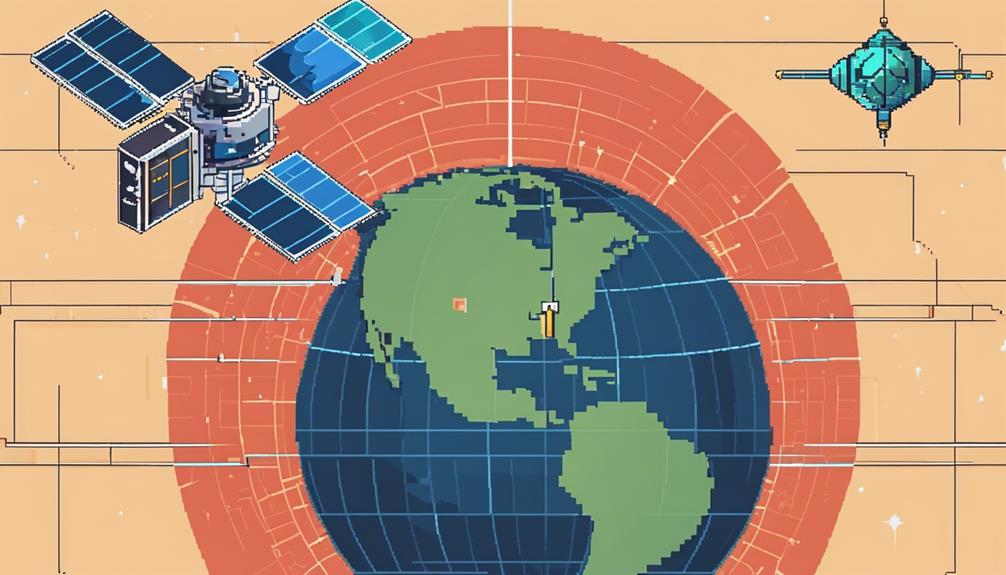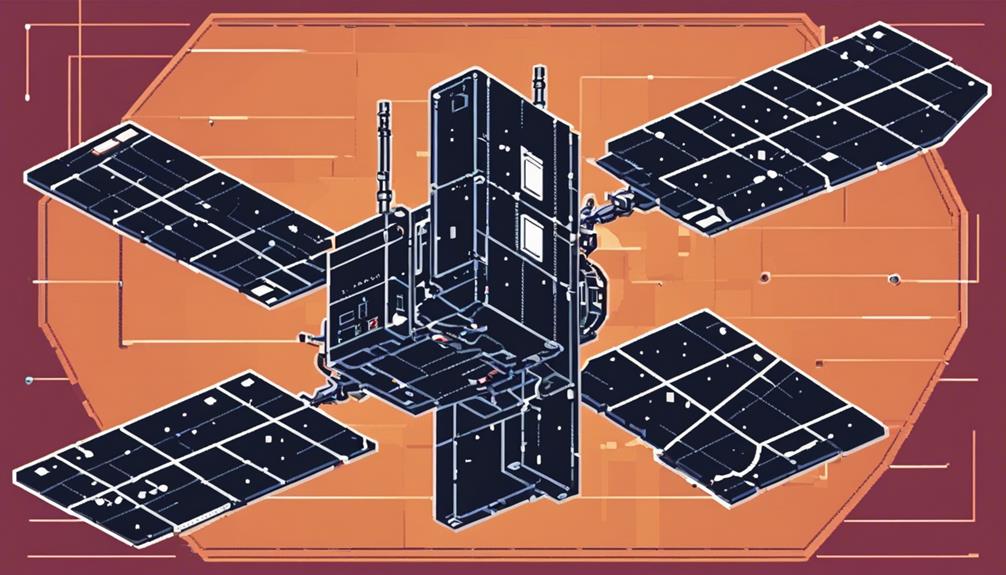Ensuring the security and encryption of satellite networks is a multifaceted endeavor that demands meticulous attention to detail. As technological advancements propel satellite communications into the forefront of global connectivity, the vulnerabilities and complexities associated with securing these networks are increasingly pronounced. From the intricacies of data encryption to the challenges posed by cyber threats, the landscape of satellite network security necessitates constant vigilance and innovative solutions. Exploring the nuances of safeguarding satellite operations unveils a realm where cutting-edge encryption technologies and collaborative efforts are paramount for fortifying the integrity of communications in the ever-evolving satellite ecosystem.
Key Takeaways
- Robust encryption is crucial for safeguarding satellite communications from cyber threats.
- Encryption algorithms like AES, RSA, and Quantum Encryption ensure data integrity and confidentiality.
- Implementing advanced encryption protocols like SSL/TLS and IPSec enhances satellite network security.
- Quantum Key Distribution and secure transmission mechanisms are key for protecting data integrity in satellite networks.
Importance of Satellite Network Security

Ensuring the robust security of satellite networks is paramount in safeguarding critical communications transmitted through orbital systems. Satellite communication systems are integral for various sectors, including telecommunications, broadcasting, and military operations, making them attractive targets for cyber threats. To counter these risks, implementing stringent security measures, such as advanced encryption, is imperative.
Encryption plays a pivotal role in securing satellite data from interception and unauthorized access. By encoding sensitive information, encryption technologies ensure that only authorized parties can decipher and access the transmitted data. Advanced encryption techniques, such as quantum cryptography, offer enhanced security against evolving cyber threats by leveraging the principles of quantum mechanics to create secure communication channels.
The vulnerabilities present in satellite communication systems underscore the critical need for robust security measures. Unauthorized access to these networks can lead to data breaches, jeopardizing sensitive information and compromising operational integrity. By prioritizing security measures like encryption, satellite operators can mitigate these risks and ensure the confidentiality and integrity of their communications.
Data Encryption in Satellites
Data encryption in satellite communication systems serves as a critical safeguard for protecting sensitive information transmitted over orbital networks. Encryption algorithms play a vital role in ensuring that mission-critical data remains secure from interception and unauthorized access during satellite communication. Protocols such as Advanced Encryption Standard (AES) and Rivest-Shamir-Adleman (RSA) are commonly employed to protect communication between ground stations and satellites, thus maintaining the confidentiality and integrity of the data being transmitted.
Innovative quantum encryption technology has also emerged as a powerful tool in enhancing data security in satellite communications. Quantum encryption leverages the principles of quantum mechanics to create secure communication channels that are highly resistant to eavesdropping and tampering. By utilizing quantum key distribution methods, satellite systems can achieve unprecedented levels of data confidentiality and protection against cyber threats.
Furthermore, the implementation of end-to-end encryption in satellite networks plays a crucial role in mitigating vulnerabilities and ensuring comprehensive security across the communication chain. End-to-end encryption secures data from the point of origin to the final destination, minimizing the risk of data breaches and unauthorized access throughout the transmission process. By incorporating robust encryption mechanisms, satellite communication systems can uphold the confidentiality and integrity of sensitive information in the face of evolving cybersecurity challenges.
Cybersecurity Measures for Satellite Communication

Implementing robust encryption protocols is fundamental to safeguarding satellite communication from potential cyber threats. In addition, integrating sophisticated threat detection systems enhances the overall security posture of satellite networks. Ensuring secure data transmission through stringent cybersecurity measures is paramount in protecting sensitive information exchanged via satellite communication channels.
Encryption Protocols Overview
The robustness of satellite communication systems against cyber threats hinges significantly on the effective deployment of encryption protocols such as SSL/TLS, IPSec, and DTLS. Quantum Key Distribution (QKD) offers a secure method for encryption key exchange in satellite networks, enhancing overall security. Implementing software-defined networking (SDN) allows for centralized control and monitoring of encryption protocols, streamlining management processes. Regular security audits and protocol updates are essential to fortify encryption measures within satellite communication systems. Advanced encryption technologies like homomorphic encryption and secure multi-party computation further strengthen security in satellite networks.
| Encryption Protocols | Key Features | Implementation |
|---|---|---|
| SSL/TLS | Secure data transmission | Widely used in web apps |
| IPSec | Network layer security | Common in VPNs |
| DTLS | Secure real-time communication | Used in IoT devices |
Threat Detection Systems
In the realm of satellite communication security, robust threat detection systems play a pivotal role in safeguarding against cyber intrusions and ensuring uninterrupted operations. These systems, including intrusion detection and prevention systems, are vital for identifying and responding to threats such as interference, eavesdropping, and injection attacks. Regular security audits are essential to uphold the efficacy of these systems. By implementing encryption and authentication protocols, the security of satellite networks can be significantly enhanced. Moreover, advanced technologies like quantum key distribution and software-defined networking are utilized to bolster the capabilities of threat detection in satellite communication. Embracing these practices ensures a proactive approach to cybersecurity in satellite networks.
Secure Data Transmission
To fortify the defenses of satellite networks against potential cyber threats, ensuring secure data transmission is paramount in preserving the integrity and reliability of communication channels.
Key Measures for Secure Data Transmission:
- Encryption Measures: Implementing robust encryption protocols such as Quantum Key Distribution (QKD) enhances the security of data transmitted over satellite networks.
- Regular Security Audits: Conducting routine security audits is crucial to identify vulnerabilities and ensure compliance with data protection standards.
- Quantum Key Distribution: Leveraging QKD technology enables the creation of secure encryption keys, enhancing the confidentiality and integrity of data transmission in satellite communication systems.
Securing Satellite Data Transmission

Implementing robust encryption technologies is paramount in ensuring the secure transmission of data across satellite networks. Encryption plays a vital role in safeguarding sensitive information as it travels between different points in the network. Technologies such as Quantum Key Distribution (QKD) offer advanced encryption capabilities that can effectively protect data from unauthorized access or interception during transmission over satellite links. Secure encryption protocols like SSL/TLS and IPSec are commonly used to establish secure communication channels between ground stations and satellites, ensuring the confidentiality and integrity of the transmitted data.
Satellite encryption solutions such as KG-255XJ and KS-252 V3.0 are specifically designed to meet the high-speed encryption requirements of satellite data transmission. These solutions provide robust encryption mechanisms that can withstand potential security threats and vulnerabilities in the satellite network environment. Moreover, the implementation of quantum channels can further enhance the security of satellite data transmission by leveraging quantum principles to secure communication links.
Ground stations serve as critical points in securing satellite data transmission by implementing encryption and authentication measures. These stations play a pivotal role in establishing secure connections with satellites and ensuring that data is transmitted securely across the network. By deploying encryption technologies and following best practices in data security, satellite operators can effectively mitigate risks and protect the confidentiality of information transmitted through satellite networks.
Authentication Methods for Satellite Networks
Authentication methods play a crucial role in ensuring the secure access and communication integrity within satellite networks. Implementing robust authentication mechanisms is essential to prevent unauthorized access and protect sensitive data transmitted between satellite and ground stations. Several sophisticated techniques are commonly employed in satellite networks:
- Biometric Verification: Biometric verification enhances security by using unique physical characteristics such as fingerprint scans, iris recognition, or facial recognition to authenticate users. In satellite networks, biometric verification adds an extra layer of protection by ensuring that only authorized personnel can access critical systems and data.
- Cryptographic Key Exchange: Secure communication in satellite networks relies on cryptographic key exchange protocols like Diffie-Hellman. These protocols facilitate the generation of encryption keys shared between satellites and ground stations, ensuring that data transmissions remain confidential and protected from eavesdropping or tampering.
- Multi-factor Authentication: Multi-factor authentication in satellite networks combines different authentication factors such as something the user knows (e.g., a password), has (e.g., a smart card), and is (e.g., biometric data). By requiring multiple forms of verification, multi-factor authentication significantly enhances security and mitigates the risk of unauthorized access, particularly in high-stakes satellite operations where data integrity is paramount.
Vulnerabilities in Satellite Networks

Satellite networks face various vulnerabilities, including threats such as eavesdropping, false signals, physical attacks, and unauthorized access, necessitating robust security measures to safeguard critical communication systems. Unauthorized access to satellite networks can lead to a range of security breaches, such as interception of network traffic and injection of false information. To address these vulnerabilities, encryption plays a crucial role in securing data transmitted over satellite links. Additionally, intrusion detection systems are essential for monitoring network activities and identifying potential security incidents in real-time.
To further understand the vulnerabilities in satellite networks, the following table provides a concise overview:
| Vulnerability | Description |
|---|---|
| Eavesdropping | Unauthorized interception of communication signals to obtain sensitive information. |
| False Signals | Injection of deceptive data or commands into the network, leading to erroneous operations. |
| Physical Attacks | Deliberate physical damage to satellite equipment or infrastructure to disrupt operations. |
| Unauthorized Access | Illegitimate entry into the network, posing risks of data theft, manipulation, or sabotage. |
Encryption Techniques for Satellite Communication
Encryption techniques play a critical role in safeguarding satellite communication networks. Key exchange methods like Quantum Key Distribution (QKD) ensure secure encryption key exchange, while Data Encryption Standards establish robust encryption protocols. Secure Transmission Protocols further enhance the confidentiality and integrity of data transmitted across satellite networks.
Key Exchange Methods
Utilizing advanced cryptographic techniques is imperative for establishing secure and reliable key exchange methods in satellite communication networks.
Key Exchange Methods:
- Quantum Key Distribution (QKD): QKD offers a highly secure method for encryption key exchange, utilizing quantum mechanics principles to ensure the confidentiality of transmitted data.
- Protection of Sensitive Data: Secure key exchange is vital to safeguard sensitive information transmitted through satellite networks, preventing interception or manipulation by unauthorized entities.
- Prevention of Unauthorized Access: Encryption techniques such as QKD help in creating secure communication channels between ground stations and satellites, mitigating the risks of unauthorized access and potential eavesdropping on the data being transmitted.
Data Encryption Standards
Establishing robust data encryption standards is paramount in ensuring the security and integrity of communications within satellite networks, with Data Encryption Standards (DES) serving as a foundational encryption technique in safeguarding transmitted data. DES operates on 64-bit blocks with a 56-bit key, providing a level of security suitable for many applications. To enhance security, Triple DES (3DES) applies the DES algorithm three times using three different keys, significantly increasing the complexity of encryption. However, the Advanced Encryption Standard (AES) has largely replaced DES due to its higher level of security and efficiency. AES offers key sizes of 128, 192, or 256 bits, making it more resistant to brute force attacks. Other encryption protocols like RSA, ECC, and Diffie-Hellman are also essential for securing satellite communication data.
Secure Transmission Protocols
Secure transmission protocols play a critical role in ensuring the confidentiality and integrity of data exchanged within satellite communication networks.
- Advanced encryption protocols such as SSL/TLS, IPSec, and DTLS are fundamental for securing transmissions in satellite communication.
- Quantum encryption technology, including Quantum Key Distribution (QKD), provides enhanced data security for satellite communications against cyber threats.
- Implementing secure encryption techniques is vital to protect sensitive mission data and communications transmitted via satellites, safeguarding against interception and potential cyber attacks.
These protocols not only establish a secure communication channel but also mitigate the risks posed by malicious entities seeking to compromise the integrity and confidentiality of data transmitted through satellite networks.
Network Security Challenges in Satellites
The complexity and vast coverage area of satellite networks pose significant challenges for ensuring robust network security. Satellite network security encompasses various aspects, including monitoring network traffic, implementing secure satellite communication, managing key distribution, and addressing system complexity. Below is a table highlighting the key challenges faced in securing satellite networks:
| Challenges | Description |
|---|---|
| Geographical Spread Vulnerability | Vulnerability to cyber threats due to the widespread coverage area of satellite networks. |
| Monitoring Complexities | Advanced security measures needed to monitor network traffic effectively across vast areas. |
| System Complexity | Challenges in ensuring comprehensive security due to the presence of multiple subsystems in satellites. |
| Regulatory Hurdles | Impact of varying laws across different regions on standardizing security protocols in satellite communication. |
| Advanced Threat Landscape | State-sponsored attacks targeting satellite networks necessitate robust security solutions. |
Addressing these challenges requires a holistic approach that integrates advanced encryption techniques, continuous monitoring systems, and stringent access controls. As the threat landscape evolves, stakeholders in satellite communication must adapt their security strategies to mitigate risks effectively. The interplay of technological advancements and regulatory frameworks will shape the future of satellite network security.
Securing Ground Stations

Securing ground stations involves implementing robust physical access controls to prevent unauthorized entry and tampering. Additionally, encryption technologies must be effectively deployed to protect data during transmission between satellites and ground stations. Ensuring the integrity and confidentiality of satellite communication networks hinges on the meticulous implementation of these security measures.
Securing Physical Access
Physical access to ground stations plays a critical role in safeguarding satellite communication equipment from unauthorized interference and breaches.
Key Measures for Securing Physical Access:
- Implementing biometric authentication methods ensures only authorized personnel can access sensitive areas within ground stations.
- Surveillance systems such as CCTV cameras and motion sensors help monitor and record activities around the premises to deter potential threats.
- Restricted access control measures, like keycard entry systems and security checkpoints, limit entry to authorized individuals, enhancing the overall physical security of ground stations.
Ensuring robust physical security protocols at ground stations, including perimeter fencing, access control systems, and security patrols, is essential in preventing intrusions and maintaining the integrity of satellite communication networks. Regular security audits and monitoring further strengthen defenses against potential vulnerabilities or breaches.
Encryption Implementation
To fortify the integrity of satellite communication networks, the robust implementation of encryption protocols at ground stations is paramount in safeguarding data transmission against unauthorized access and cyber threats. Encryption implementation in ground stations ensures secure communication by utilizing protocols like SSL/TLS, IPSec, and DTLS to protect data during transmission. This approach guarantees data confidentiality, integrity, and authenticity within satellite networks, preventing any unauthorized access to sensitive information. Ground stations play a crucial role in securing both uplinks and downlinks of satellite communication through the deployment of encryption techniques. By incorporating encryption at ground stations, satellite networks can effectively mitigate cyber threats and uphold the confidentiality of valuable data, thus enhancing overall network security.
Collaboration for Satellite Network Security
In the realm of satellite network security, fostering collaboration among industry stakeholders is paramount for enhancing overall cybersecurity defenses and resilience. This collaborative approach in satellite network security involves sharing threat intelligence, best practices, and expertise among various entities involved in the satellite communication ecosystem. The following key aspects highlight the importance of collaboration for satellite network security:
- Threat Intelligence Sharing: Collaboration enables the sharing of real-time threat intelligence data among satellite operators, cybersecurity firms, and government agencies. This information exchange helps in identifying potential vulnerabilities and understanding the evolving threat landscape in satellite networks.
- Standardized Security Protocols: Joint efforts focus on developing and implementing standardized security protocols across satellite networks. By establishing common security standards, the industry can ensure consistent protection measures are in place to safeguard against cyber threats and unauthorized access.
- Enhanced Encryption Methods: Collaborative initiatives aim to enhance encryption methods used in satellite communication. By working together to improve encryption technologies, industry stakeholders can strengthen data protection, confidentiality, and integrity within satellite networks, ensuring secure transmission of sensitive information.
Next-Gen Solutions for Satellite Security

Exploring cutting-edge encryption technologies and advanced network management strategies is paramount in the development of next-generation solutions for satellite security. In the realm of satellite communications, safeguarding data transmission against cyber threats is essential. Next-gen solutions incorporate innovative approaches such as Quantum Key Distribution (QKD) to establish secure key exchange mechanisms that are resistant to hacking attempts. Additionally, the adoption of Software-Defined Networking (SDN) in satellite systems enables centralized control and monitoring, enhancing overall security by allowing for dynamic security protocol updates and rapid threat responses.
To provide a clearer overview, the table below outlines key components of next-gen satellite security solutions:
| Component | Description | Benefits |
|---|---|---|
| Quantum Key Distribution (QKD) | Utilizes principles of quantum mechanics to secure key exchange, offering unparalleled encryption | Enhanced security against sophisticated cyber threats |
| Software-Defined Networking | Enables centralized control and monitoring of satellite systems for dynamic security management | Improved agility in responding to evolving security risks |
| Regular Security Protocol Updates | Ensures that security measures are up-to-date to defend against emerging threats | Maintains the resilience of satellite networks |
Frequently Asked Questions
What Is Satellite Encryption Security System?
A satellite encryption security system is a sophisticated technology that utilizes encryption algorithms to safeguard data transmitted between ground stations and satellites. It plays a crucial role in protecting sensitive information from cyber threats, ensuring data protection during satellite transmissions. These systems are designed to address vulnerabilities in satellite encryption, guaranteeing the confidentiality, integrity, and availability of communication networks. Advanced encryption technology is vital for enhancing the security of satellite networks.
Are Satellite Data Encrypted?
Data privacy is a critical concern in modern communication networks, with encryption playing a pivotal role in safeguarding sensitive information. Cyber threats pose a significant risk to data integrity, making encryption protocols essential for secure transmissions. Encryption ensures that only authorized parties can access data, mitigating the risk of signal interference and unauthorized access. By encrypting satellite data, organizations can enhance data privacy, protect against cyber threats, and maintain the confidentiality of their communications.
How Secure Is Satellite Internet?
When evaluating the security of satellite internet, factors such as cyber threats, network vulnerabilities, data privacy, and the utilization of emerging technologies must be considered. Robust security measures are essential to mitigate cyber threats and safeguard data privacy. Constant monitoring, timely updates, and the adoption of cutting-edge encryption technologies play a crucial role in enhancing the security posture of satellite internet connections, ensuring a secure and reliable communication environment.
How Do You Secure Satellite Communication?
To secure satellite communication, various measures must be implemented. Signal interference can be mitigated through frequency hopping techniques. Ground station security is crucial to prevent unauthorized access. Satellite tracking helps monitor and manage communication links effectively. Employing encryption protocols, conducting security audits, and utilizing intrusion detection systems are essential for robust protection. Collaboration and information sharing enhance overall security measures in satellite communication networks.
